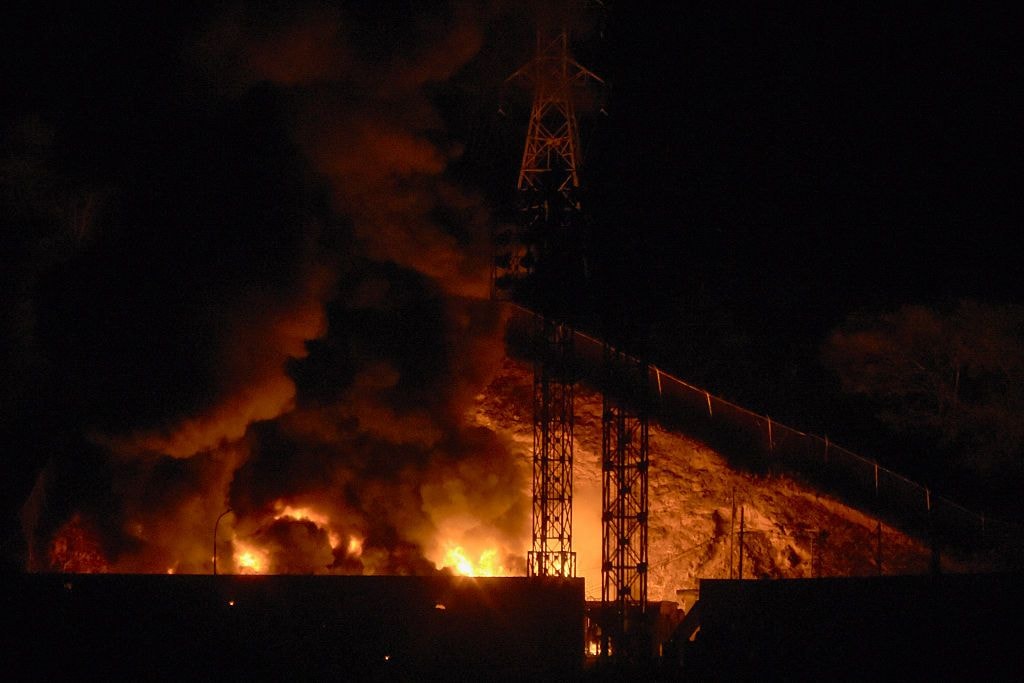Record Russian armor, personnel losses in failed attempt to take Avdiivka by storm

Winter is coming in Ukraine, and as it approaches, just as last year, Russia has gone on the offensive in the east.
Starting on Oct. 9, dozens of Russian armored vehicles backed by thousands of infantry personnel, artillery, and air power, were launched at the flanks of the city of Avdiivka, a Ukrainian stronghold city still standing since 2014 just outside occupied Donetsk.
Two weeks in, the offensive has been an undisputed failure so far. Russian gains have amounted to little more than a handful of treelines on the flanks.
Instead of the rapid advances Moscow was hoping for, the Russian attacking force achieved fame as the main characters in a seemingly endless stream of Ukrainian drone footage of destroyed Russian armor in the fields around the city.
The scenes captured from the air are dramatic, showing tens of millions of dollars worth Russian equipment falling victim to Ukrainian artillery, anti-tank fire, and FPV (first-person view) kamikaze drones. Videos filmed by Russian and Ukrainian soldiers on the ground show dozens of dead bodies scattered among the destroyed vehicles.

“It was pure chaos, the amount of troops they were sending into the assault was pretty ridiculous,” said Ryan O’Leary, the American commander of Chosen Company, an assault unit of foreign volunteer fighters in the 59th Mechanized Brigade, to the Kyiv Independent.
“It doesn't seem like the Russians even knew what they were doing, it doesn't seem like it was planned out very well, at least the ground troops didn't have a clue.”
On Oct. 19, after a brief lull in the fighting, Russia sent fresh waves of armored vehicles at Avdiivka, with the same result: heavy losses in heavy battles with very little gains to speak of.
The scale of the carnage that day was revealed in the daily report on Russian losses the next morning.
The General Staff tallied 1,380 personnel, 55 tanks, and 120 armored fighting vehicles as lost by Russian forces that day alone, all record numbers since the military began releasing official figures in March 2022.
The amount of geolocated visual evidence, backed by reports on Russian and Ukrainian Telegram channels left no doubt that the bulk of these losses came in the Avdiivka sector.
“They are probably pretty close on the equipment loss because that is easy to verify,” said O’Leary about the General Staff figures, “but the estimates of the infantry dead and wounded from their assaults are probably actually lower than reality.”

The offensive on Avdiivka has drawn comparisons to Russia’s similarly fruitless armored assault on Vuhledar in southern Donetsk Oblast last winter, but also to the battle of Bakhmut, where Russia committed a large force to try and surround a “fortress” city when frontal attacks initially failed.
Although Russian forces came very close to surrounding Bakhmut, their efforts were ultimately denied by a spirited Ukrainian defense, forcing the Wagner Group to take the city street by street in brutal urban fighting.
According to O’Leary, whose unit is fighting on the city’s southern flank, the calamitous tactics used by Russia in Avdiivka are not comparable even to Bakhmut.
“They weren't doing what they were doing in Bakhmut where they would send 12 guys in, then another 12,” he said.
“Here they would push 80 guys with armor down this road and see what happens, and if it didn't work, they would push another 80 guys in and see what happens this time, and so on.”
Why Avdiivka?
Of all the areas of the front line that Russia could choose to target when it regained the initiative, Avdiivka was always an obvious choice.
Over the first year of the full-scale war, Russian forces had slowly but surely pushed past the contact line that had run through the area since Russia’s war began in 2014, taking significant territory on both the northern and southern flanks of Avdiivka but failing to mount a successful front-on assault on the city itself.
Fresh attacks in March this year closed the pincers even further, and by the end of that month, Ukrainian military spokesperson Oleksii Dmytrashkivskyi warned that the city could become a “second Bakhmut.”
The comparison was apt then and remains to this day: the Ukrainian presence in Avdiivka is the most prominent salient on the map, with just over eight kilometers between Russian positions on the flanks, and only one main sealed road into the city.
“The Ukrainians knew it was coming, they might not have known where exactly but they knew the Russians were building forces,” O’Leary said.

Even if Russia fails to completely encircle Avdiivka, a slower, attritional fight could come at a higher relative cost to Ukrainian forces under fire from three sides, as was the case in Bakhmut.
Quick victory in Avdiivka would also be an undeniable major political boon for Moscow. The last major city taken by either side was Bakhmut, the ruins of which fell to Russian forces in May at a cost so high that Ukraine was able to immediately start counterattacking in the area.
Political motivations to take the city also hold a deep propaganda element.
Avdiivka, where the northern neighborhoods of Donetsk are easily visible from the roofs of apartment buildings, has played a central role in Russia’s years-long disinformation campaign accusing Ukraine of shelling civilians in Donbas, which became one of the central public justifications for the full-scale invasion.

The geography of Avdiivka presents its own challenges to the Russian side.
Ukrainian positions on the southern edge of the city, facing Donetsk, are largely the same ones held since 2014, and have been fortified and strengthened in preparation for a head-on Russian attack.
North of the urban area lies the enormous Avdiivka Coke Plant, itself prepared as a fortress long in advance much like the Azovstal steel plant in Mariupol, which a small, depleted, and encircled Ukrainian force held for over six weeks against all odds.
Next to the plant rises a large slag heap of waste product from the plant, typical to the industrial landscape of Donetsk Oblast. Though considered a strategic height, the slag heap also offers next to no cover from enemy fire for forces occupying it. According to Ukrainian journalist Yurii Butusov, after numerous Russian attempts to take it, the slag heap has become a “grey zone” not held by either side as of Oct. 23.
Beyond Avdiivka itself, the wide open, well-defended terrain in this part of Donetsk Oblast makes the prospects of rapid progress unlikely, even in the event of capturing Avdiivka.
Tactical tangle
As Russian artillery sounded around Avdiivka without respite and Russian attack helicopters flew low over occupied Donetsk, the country’s infamous “milbloggers” (military bloggers) on Telegram initially claimed deep advances into Ukrainian-held territory. Several accounts claimed that Russian forces had reached the village of Berdychi, which would have brought them just a few kilometeres from the main road to Avdiivka.
If Russia could really have reached and held the settlement, the threat of encirclement could have become very real. Very quickly, however, the reports turned out to be little more than wishful thinking.
As the first attacks were fought off, Russia’s hopes of a quick victory tempered quickly. The tone was set early on: in one of the first videos to emerge of the attacks on Oct. 10, a Russian tank at the head of a long column was seen to veer off a makeshift bridge into a canal near the village of Vodiane.
Over the next few days, the area quickly turned into a haphazard graveyard of Russian armored vehicles.
“In one operation my guys went out against,” said O’Leary, “they (Russian forces) used six BMPs (Soviet-designed infantry fighting vehicles) and only two made it out damaged, the rest are sitting there burning in the field.”
Russia’s choice to launch a large-scale offensive on Avdiivka may have been expected, but the tactics employed came as a surprise to many. Both sides have dug in along a front line that has remained much more static over 2023 than in 2022, making armored maneuver warfare more and more difficult to carry out.
“The Russians are, to some extent, running into some of the same problems that the Ukrainians have run into in their offensive in the south,” said Emil Kastehelmi, a Helsinki-based analyst from Finnish open-source intelligence organization Black Bird Group, to the Kyiv Independent.
“Strong minefields do work, and if you just try to rush across fields where enemy aerial reconnaissance will surely see all your movements, then this is the end result.”
The scenes of clusters of destroyed armored vehicles in the fields do resemble the failed Ukrainian armored attacks near Orikhiv in Zaporizhzhia Oblast in the first days of the southern counteroffensive, but the scale of the Russian assault on Avdiivka is unarguably larger.

According to Butusov, Russia has committed armored units from four motorized rifle brigades to the attack, bolstered by paratroopers and tank battalions from other units.
“The Russians are pushing with what looks like a regimental-level force,” said Kastehelmi.
“It's a very strong push, we haven’t seen something like this in a very long time from the Russians, which means that they are trying to get the initiative, at least locally.”
However big the Russian force was, the way it was used completely fits the definition of the “human wave” or “meat assault” tactics Russia became notorious for in Bakhmut, according to O’Leary.
“There are some Russian units that no longer really exist, they were just completely wiped out,” he said.
But unlike in Bakhmut, where small squad-level assaults were largely conducted by the Wagner mercenary group’s expendable units of convict soldiers, here, it is the regular Russian army that is taking the brunt of the losses.
“Some of the people we killed turned out to be contract soldiers, not mobilized, so it's human waves, but with their trained guys,” O’Leary added.
“None of it made any sense.”
Lessons for winter
As shambolic and unfruitful it has been so far, Russia’s assault on Avdiivka also comes with serious warning signs for Ukraine ahead of the winter campaign.
The intensity of fighting over the summer, which saw hardened Russian units often transferred from one sector of the front line to shore up defenses in another, gave rise to assessments that Russia was suffering from a lack of reserves in the face of severe attrition.
“It proves that the Russians have not yet come close to running out of reserves and equipment, they still seem to be determined to continue offensive actions,” said Kastehelmi.
“There has been talk about Russian forces being severely depleted but there hasn't been any concrete proof for that, it's just more of an assumption that some have made.”
The scale and boldness of Russia’s attack also could indicate that Moscow has assessed that the Ukrainian counteroffensive on the southern front line has culminated or is approaching its culmination.
Russian milbloggers still continue to report Ukrainian attacks on the key settlement of Verbove in Zaporizhzhia Oblast, though significant gains have not been observed in the area since Ukrainian forces achieved a narrow breach of the Surovikin line of defense over August and September.

Just as it was too early to judge Ukraine’s summer counteroffensive achievements a month into the operation, Russia’s push on Avdiivka is only two weeks old.
Even if attempts at a quick encirclement fail, the high value Moscow has placed on taking Avdiivka indicates that the area will likely remain a hotspot of Russian attacks in the coming months.
“There is always the question of whether they should change to the smaller infantry group tactics which we saw in the battle of Bakhmut,” said Kastehelmi, “with the state of the losses that they have taken already it's unlikely that they can continue this offensive with this approach for very long.”
“They're going to be using less armor because they lost it all,” said O’Leary.
“They're not changing from their human wave tactic, now it's just on a different scale because they don't have the machinery available.”
Whether or not they later opt to change tactics, Russian forces’ hapless attempt to quickly encircle Avdiivka is yet another sign that neither side is likely to have success taking large areas in maneuver-based offensives in the future of the war.
“It's possible that some small territories, a couple of villages could change hands quickly,” Kastehelmi said.
“But if we think of a breakthrough, a systematic collapse of defenses in a large area with larger operational implications, I don't think we will see something like this any time soon.”

Note from the author:
Hi, this is Francis Farrell, cheers for reading this article. We are entering a new phase of the war, which could potentially be stranger, tougher, and more uncertain than it has ever been so far. In a time when instability around the world is growing, and attention is fading when it is needed the most, please consider supporting our reporting.













